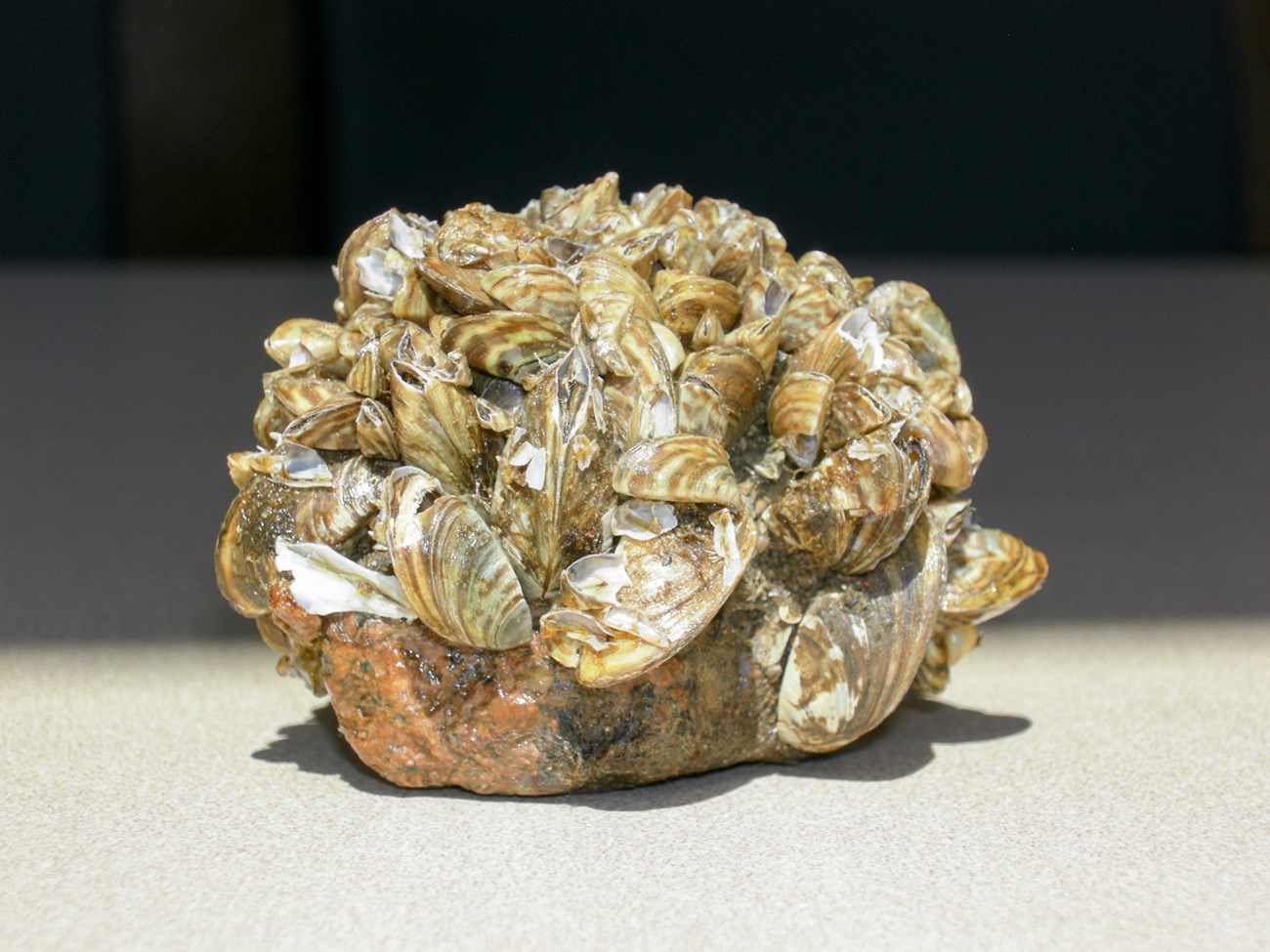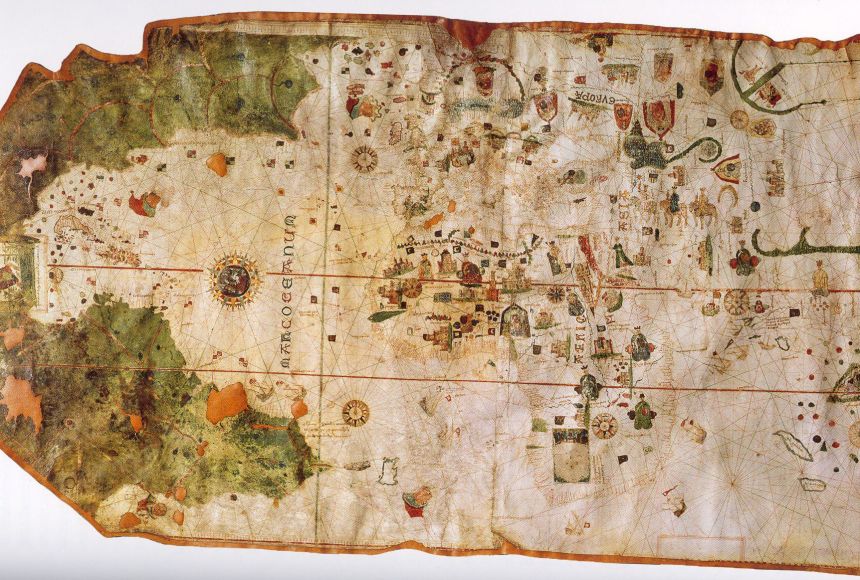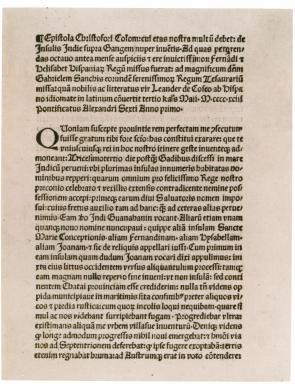When Christopher Columbus and his crew arrived in the New World, two biologically distinct worlds were brought into contact. The human, animal, plant, and bacterial life of these two worlds began to mix in a process called the Columbian Exchange. The results of this exchange recast the biology of both regions and altered the history of the world.
Between 280 million and 225 million years ago, the earth's previously separate land areas became welded into a landmass called Pangaea. About 120 million years ago this landmass began to separate. As this happened, the Atlantic Ocean formed, dividing the Americas from Africa and Eurasia. Over the course of the next several million years in both the Americas and in Afro-Eurasia, biological evolution followed individual paths. This created two unique biological worlds. However, when Christopher Columbus and his crew landed in the Bahamas in October 1492, these two long-separated worlds were reunited. Columbus' voyage and those after disrupted the biological spheres of each place.
Columbus' arrival in the Americas was first studied seriously by an American historian named Alfred Crosby. He identified it as the Columbian Exchange. By reuniting biologically unique land masses, the Columbian Exchange had dramatic and lasting effects on the world. New diseases were introduced to Native people of the Americas that had no immunities to them. The results were devastating. Europeans also introduced to Native people new weeds and pests, livestock, and pets. The Columbian Exchange also began the Trans-Atlantic Slave Trade. Between 1525 and 1866, Europeans enslaved 12.5 million people from (mostly west) Africa and brought them to the Americas. New food and fiber crops were also introduced to Eurasia and Africa. The new crops changed diets and patterns of trade there. In addition, the Columbian Exchange also vastly expanded the production of popular drugs. Goods like coffee, sugar, and tobacco became used by many millions of people.
From Old to New: Disease
A significant impact of the Columbian Exchange was the introduction of new diseases into the Americas. When the first inhabitants of the Americas arrived across the Bering land bridge between 20,000 and 12,000 years ago, they brought few diseases with them. They had no domesticated animals, and those were the original source of human diseases such as smallpox and measles. In addition, as they passed from Siberia to North America, the first Americans had spent many years in extreme cold, which eliminated many of the disease-causing agents that might have traveled with them. As a result, Native people in the Americas, numbering between 40 million to 60 million by 1492, had little to no infectious diseases that plagued populations in Afro-Eurasia. Meanwhile, in Asia and Africa, the domestication of herd animals brought new diseases spread by cattle, sheep, pigs, and fowl.
After 1492, sailors introduced these diseases — including smallpox, measles, mumps, whooping cough, influenza, chicken pox, and typhus — to the Americas. People who lived in Afro-Eurasia had developed some immunities to these diseases because they had long existed among most Afro-Eurasian populations. However, the Native people of the Americas had no such immunities. Adults and children alike were stricken by numerous viral epidemics. The epidemics killed many Native people throughout the Americas. In the larger centers of highland Mexico and Peru, many millions of people died. On some Caribbean islands, the populations of Native people died completely. In all, between 1492 and 1650, diseases killed about 90 percent of all Native people in the Americas.
This loss is considered among the largest demographic disasters in human history. The significant loss of human life rocked the region's ecological and economic balance. Ecosystems were disrupted as forests regrew and previously hunted animals increased in number. Colonial economies like Spain also used enslaved Native labor. In fact, Columbus even enslaved the first group of people with whom he made contact, the Taíno (Ti-ee-no). "There [in the Americas] I found very many islands, filled with innumerable people, and I have taken possession of them all for their Highnesses [of Spain]." The mass death of the Native people of the Americas brought by the Columbian Exchange indirectly caused a drastic labor shortage. This directly contributed to the establishment of Trans-Atlantic Slave Trade. Colonial powers wanted cheap labor in the form of enslaved African people to perform hard jobs like sugar farming and silver mining. By 1650, the Trans-Atlantic Slave Trade had brought new diseases, such as malaria and yellow fever, which further plagued Native people.
From Old to New: People, Animals, Crops
Eurasians sent much more than disease westward. The introduction of new crops and domesticated animals to the Americas did almost as much to disrupt the region as diseases had. Columbus had wanted to establish new fields of plenty in the Americas. On his later voyages he brought many crops he hoped might flourish there. He and his followers brought the familiar food grains of Europe: wheat, barley, and rye. They also brought Mediterranean plantation crops such as sugar, bananas, and citrus fruits, which all had originated in South or Southeast Asia. At first, many of these crops fared poorly; but eventually they all flourished. After 1640, sugar became the staple of the Caribbean and Brazilian economies. As sugar plantations were commonly worked with enslaved African laborers, these places became some of the largest slave societies ever known. The production of rice and cotton, both imported in the Columbian Exchange, together with tobacco, formed the basis of slave society in what is now the United States. Wheat also thrived in the temperate latitudes of North and South America and in the highlands of Mexico. By the late 20th century, wheat exports from Canada, the United States, and Argentina fed millions of people outside the Americas. The new crops imported by Europeans supported their settler societies and the African people that they enslaved. American Indian people preferred their own traditional foods.
The Columbian Exchange also brought horses, cattle, sheep, goats, pigs, and other species to the Americas. Before Columbus, American Indian societies in the Andes Mountains had domesticated llamas and alpacas, but no other animals weighing more than 45 kg (100 lbs). None of the other twenty-three large mammal species present in the Americas before the arrival of Columbus were suitable for domestication. In contrast, Eurasia had seventy-two large animal species, of which thirteen were suitable for domestication. The main domesticated animals of the pre-Colombian Americas, aside from llamas and alpacas, were dogs, turkeys, and guinea pigs.
Of all the animals introduced by the Europeans, the horse was particularly important. Some American Indian nations like the Inca first encountered it as a fearsome war beast ridden by Spanish conquistadors. Some nations peoples soon learned to ride and raise horses themselves. In the North American Great Plains, the arrival of the horse revolutionized Native life. The horse permitted Nations and their people to hunt the buffalo far more effectively. Several groups of Native peoples left farming to become buffalo-hunting nomads. They also became strong enemies of European expansion in the Americas. Notably, the arrival of the horse is particularly important to North Carolina. In the Outer Banks, wild horses descended from Spanish mustangs still roam and live today.
Cattle, sheep, pigs, and goats also proved popular in the Americas. Within 100 years after Columbus, huge herds of wild cattle roamed many of the natural grasslands of the Americas. Wild cattle, and, to a lesser degree, sheep and goats, damaged the food crops of Native people, notably in Mexico. Eventually ranching economies emerged. They were based variously on cattle, goats, or sheep. The largest ranches emerged in the grasslands of Venezuela and Argentina, and on the grasses that stretched from northern Mexico to the Canadian prairies. Some nations of Native people used the livestock for meat, tallow, hides, transportation, and hauling.
Pigs also spread in unique ways. Hernando de Soto expeditions brought the first domesticated pigs to North America in the 1500s. Important to North Carolina are the descendants of De Soto's pigs: feral swine. According to the USDA, " [Spanish] free-range livestock management practices and escapes from enclosures led to the first establishment of feral swine populations within the United States. In the 1900s, the Eurasian or Russian wild boar was introduced into parts of the United States for the purpose of sport hunting. Today, feral swine are a combination of escaped domestic pigs, Eurasian wild boars, and hybrids of the two." The feral pig is commonly found across most of North Carolina even today. Many people in the state hunt the wild pigs for food.
From New to Old: Disease
Few diseases travel from the Americas to Afro-Eurasia. The flow of disease from the Americas eastward into Eurasia and Africa was either trivial or consisted of a single important infection. Much less is known about pre-Columbian diseases in the Americas than what is known about those in Eurasia. Based on their study of skeletal remains, anthropologists found that Native people of the Americas suffered from arthritis. They also had another disease, likely a form of tuberculosis that may or may not have been similar to the pulmonary tuberculosis common in the modern world. Native people of the Americas also suffered from a group of illnesses that included two forms of syphilis. There are many theories that explain the spread of syphilis. A popular theory claims that Columbus's original crew transmitted the disease back to Europe on their return voyage in 1493. A Spanish physician, Ruy Diaz de Isla, documented the "unknown disease, so far not seen and never described" in Barcelona in 1493. However, the true cause of the transmission of syphilis is unknown.
From New to Old: Crops and cuisine
New plant species and cuisines from the Americas also transformed life in places as far apart as Ireland, South Africa, and China. Before Columbus, the Americas had many different domesticated plants. By Columbus's arrival, dozens of plants were in regular use. The most important staples were maize (corn), potatoes, cassava, and various beans and squashes. Lesser crops included sweet potato, papaya, pineapple, tomato, avocado, guava, peanuts, chili peppers, and cacao (the raw form of cocoa). Within twenty years of Columbus' last voyage, maize had established itself in North Africa and Spain. It spread to Egypt, where it became a staple in the Nile Delta, and from there to the Ottoman Empire, especially the Balkans (southeast Europe). By 1800, maize was the major grain in large parts of what is now Romania and Serbia. It was also important in Hungary, Ukraine, Italy, and southern France. It was often used as animal feed. People ate it too, usually in a porridge or bread. Maize appeared in China in the 1500s and eventually supplied about one-tenth of the grain supply there. In the 1800s, it became an important crop in India. Maize probably played its greatest role, however, in southern Africa. There, maize arrived in the 1500s due to the trans-Atlantic Slave Trade. Southern African environmental conditions, across what is now Angola, Zambia, Zimbabwe, Mozambique, and eastern South Africa, suited maize well. Over the centuries, maize became the primary peasant food in much of southern Africa. In late 1900s South Africa, for example, maize grew in two-thirds to three-quarters of the region's cropland.
The potato also impacted the food supplies and in promoted population growth in Eurasia. The potato had little impact in Africa, where conditions did not suit it. But in northern Europe the potato thrived. It had the most significant effect on Ireland, where it promoted a rapid population increase. In 1845, a potato blight ravaged the crop and brought widespread famine to the area. After 1750, Scandinavia, the Low Countries, Germany, Poland, and Russia also grew the potato, which helped drive a general population explosion in Europe. The potato also fed mountain populations around the world, notably in China, where it encouraged settlement of mountainous regions.
Other crops from the Americas were similarly important. In West Africa, peanuts and cassava provided new foodstuffs. Cassava, a tropical shrub native to Brazil, has starchy roots that will grow in almost any soil. In the leached soils of West and Central Africa, cassava became an important crop. Today some 200 million African people rely on it as their main source of nutrition. Cacao and rubber, two other South American crops, became important export items in West Africa in the 1900s. Rubber export and harvest were central parts of Belgium's 1880s genocide in the Congo. The sweet potato, which was introduced into China in the 1560s, became China's third most important crop after rice and wheat. It proved a useful supplement to diets throughout the monsoon lands of Asia. Indeed, almost everywhere in the world, many American food crops became popular. They complemented existing crops or, sometimes, replaced them. By the late 1900s, about one-third of the world's food supply came from plants first domesticated in the Americas.
In contrast, the animals of the Americas have had very little impact on the rest of the world. The camel and the horse actually originated in North America and migrated westward across the Bering land bridge to Asia, where they evolved into the forms familiar today. By the time of the Columbian Exchange, these animals were long extinct in the Americas, and the majority of America's domesticated animals would have little more than a tiny impact on Afro-Eurasia. One domesticated animal that did have an effect was the turkey. Wild animals of the Americas have done only a little better. Probably after the 19th century, North American muskrats and squirrels successfully colonized large areas of Europe. Deliberate introductions of American animals occasionally led to escapes and the establishment of feral animal communities. One such example is raccoons which were fancied for their fur and were imported to Germany in the 1920s. However, no species introduced from the Americas revolutionized human affairs or animal ecology anywhere in Afro-Eurasia.
The Columbian Exchange in the modern world
As the late dates of the introduction of muskrats and raccoons to Europe suggest, the Columbian Exchange exists still today. Recently, for example, zebra mussels from the Black Sea, stowed away in the ballast water of ships, invaded North American waters. There they blocked the water intakes of factories, nuclear power plants, and municipal filtration plants throughout the Great Lakes region. Just as the arrival of Christopher Columbus's ships in America in the 1400s resulted in the worldwide exchange of disease, crops, and animals, the 20th-century practice of ships using water as ballast helped unite the formerly diverse flora and fauna of the world's harbors and waterways. Similarly, air transport allows the spread of insects and diseases that would not easily survive longer, slower trips. To date, however, the world historical importance of modern exchanges pales beside that which took place in the original Columbian Exchange.
Guided Reading Questions:
- About how many African people were enslaved and brought to the Americas in the Trans-Atlantic Slave Trade?
- Name three (3) diseases that Europeans brought to the Americas during the Columbian Exchange.
- Who were the first people Columbus met when he arrived in the Americas in 1492?
- Name two (2) crops that Europeans brought to the Americas.
- What was one (1) animal that people in the Americas domesticated before the Columbian Exchange?
- Name one (1) animal that the Columbian Exchange brought to North Carolina.
- Did any diseases from the Americas spread through the rest of the world? Can you name one (1)?
- Name two (2) crops that pre-Columbian people of the Americas farmed that are now popular foods.


 Invasive Zebra Mussels
Invasive Zebra Mussels



